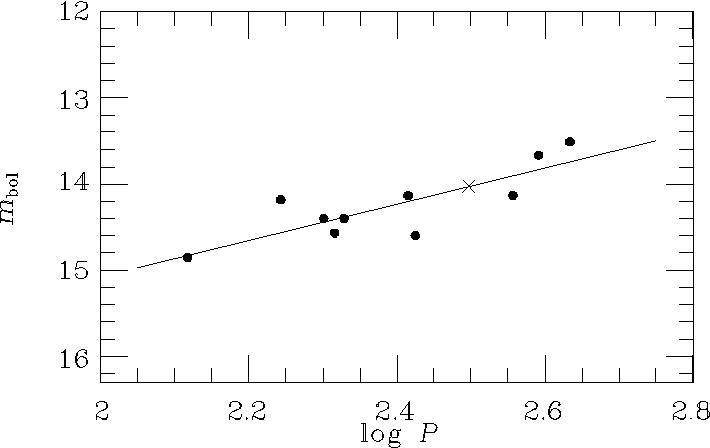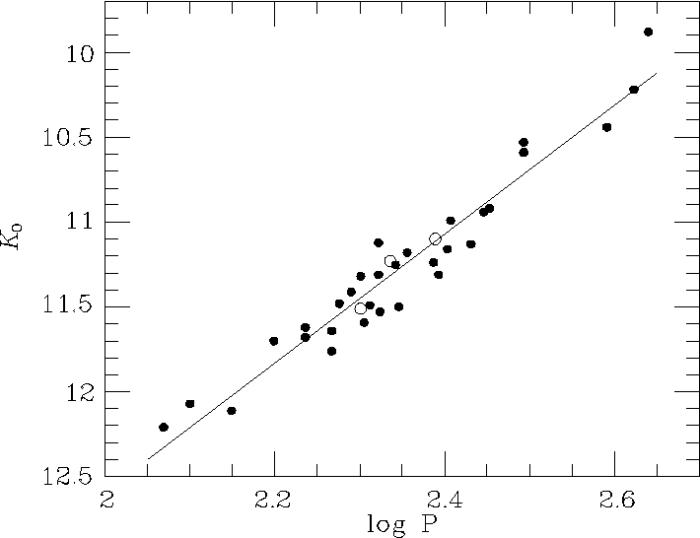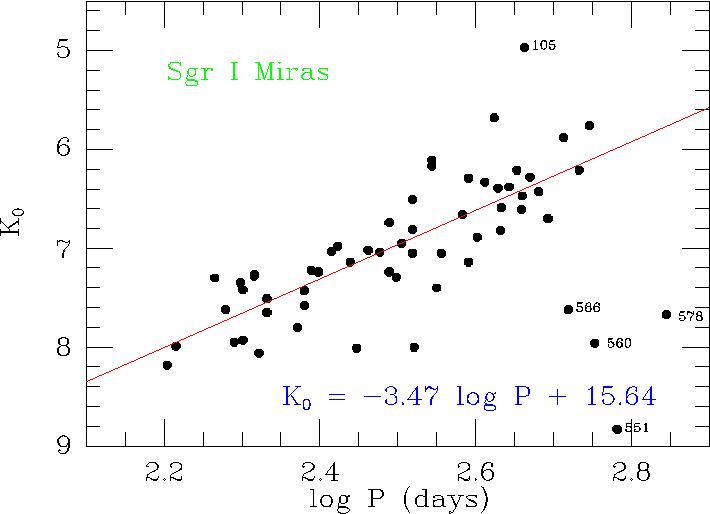My attention was drawn to long-period variables in the LMC by the late Louise Webster. T Lloyd Evans had located some examples in the LMC and I obtained infrared photometry of them which showed that they obeyed a clear period-luminosity relation, something that had eluded earlier investigators who had concentrated on the visible region. This was published by Glass and Lloyd Evans, Nature, 291, 303 (see diagram below).

Following this work, I undertook a programme to look at a much larger
sample of variables in the LMC, and was later joined by P.A. Whitelock, R.M.
Catchpole, M.W. Feast and C.D. Laney. The first report of this programme
was by Glass et al (1987), in Kwok and Pottasch
eds, Late Stages of Stellar Evolution, Reidel, Dordrecht, p51. It
was shown (a) the M stars obey a tight K, log P relation with a scatter of
0.13 mag (see diagram below) and (b) that M and C Miras obeyed the same
logP-MK relation, but that the C-Miras tended to have fainter
M

The full data were published in SAAO Circulars, 14, 63, 1990. The final P-L relations were given in Feast et al MNRAS, 241, 375, 1989, together with some evidence for the existence of a P-L-C relation for M-type Miras.
Subsequent papers with other members of the SAAO group, as well as I.N. Reid (Caltech) (MNRAS, 214, 405, 1985; MNRAS, 232, 53, 1988) have helped to define the limits of validity of this relation. For example, in the Sgr I field of low extinction, the mass-loss associated with periods longer than about 350 days causes these stars to appear fainter than expected from the LMC P-L relation.
The P-L relation derived from the LMC was shown to be obeyed by C Miras in the SMC by Lloyd Evans, Glass and Catchpole (MNRAS, 231, 773, 1988).
The calibrating stars of the Mira P-L relation were re-visited when improved light curves became available from the MACHO data base. These were used to re-discuss the periods and amplitudes of the calibrating stars of the Mira P-L relations by Glass and Lloyd Evans MNRAS, 343, 67, 2003.
Miras in the Baade's Window Bulge fields
Photometry of Mira variables located by Lloyd Evans (MNRAS 174, 169, 1976) in the NGC6522 and Sgr I "windows" of low extinction was obtained and used to discuss the distance to the Galactic Centre (Glass and Feast, MNRAS, 198, 199, 1982), based on the previously found LMC P-L relation.
An extensive programme of monitoring of the known Mira variables and IRAS sources in the Sgr I Baade's Window was reported by Glass, Whitelock, Catchpole and Feast MNRAS, 273, 383, 1995. The census of long-period variables is believed to be complete in this area. P-L relations, colour-period relations and the distance to the Centre are discussed. The longer-period variables frequently show magnitudes fainter than expected, probably because of obscuring circumstellar dust shells (see below).

Long-Period Variables in the Galactic Centre
Using the PANIC large-format PtSi infrared camera, a search for long-period variables in the Galactic Centre was conducted over 4 seasons, resulting in the discovery of about 400 variables in an area of about 24 x 24 arcmin2 See Galactic Centre Variable Star Survey and diagram below. These stars have been surveyed for SiO emission using the Nobeyama mm-wave telescope in Japan (Deguchi et al, PASJ, 56, 261, 2004), and their usefulness as kinematic indicators has been demonstrated.

Caption: The 25 subfields of the 24' x 24' LPV survey. Dots are the large-amplitude variables (Glass, Matsumoto, Carter, Sekiguchi, MNRAS, 321, 77, 2001). Squares are known OH/IR sources. Triangles are serendipitously discovered variables from Wood et al (A and A, 336, 925, 1998.